Research Gallery > Star Formation Studies
Research Gallery
Star Formation Studies
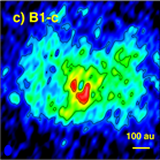 |
ALMA revealed the earliest stage of protostellar evolution Three extremely young low-mass protostars, B1-bN, B1-bS, and B1-c, observed with the ALMA at a resolution of ~0.2" (= 47 au). The upper panels show the images of C17O 2-1 ...(more) |
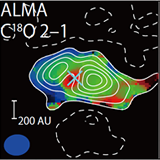 |
An extremely young protostar, SMM11, observed in millimeter wavelength An extremely young protostar, SMM11, in the Serpens Main cluster forming region observed with ALMA in 1.3 mm continuum, 12CO J=2-1 line, and C18O J=2-1 line. These results, as well ...(more) |
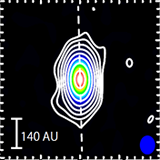 |
Visibility distribution of the protostar L1527 IRS in 220 GHz continuum Visibility distribution of the protostar L1527 IRS observed with ALMA in 220 GHz continuum. Visibility distributions are the Fourier transform of images. The amplitude distribution of this protostar is narrower ...(more) |
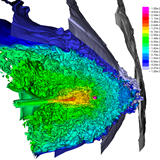 |
How a supernova affects a nearby star-forming galaxy? The image shows the turbulent gas when a supernova collides with a nearby star-forming galaxy. ...(more) |
![The [Ne III] Jet of DG Tau and Its Ionization Scenarios](_img/2016_StarFormation_S_20180430080256.jpg) |
The [Ne III] Jet of DG Tau and Its Ionization Scenarios Kinematic properties of velocity-decomposed [Ne III] λ3869 emission are shown in a position–velocity (pv) diagram (left panel), a spatial profile along the jet axis (central panel), and line profiles at ...(more) |
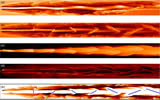 |
A study of the wiggle morphology of HH 211 through numerical simulations: View of the simulation 2D slices through the centre of the 3D domain of our simulations. Panel (a) shows log of density of our steady jet velocity simulation. It can be directly compared to ...(more) |
 |
A study of the wiggle morphology of HH 211 through numerical simulations Top panel: a reproduction of fig. 1(b) from Lee et al. (2010) showing the CO emission integrated intensity map of HH 211 within 17 arcsec from the source. The red ...(more) |
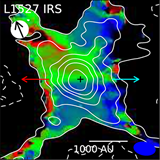 |
Infalling and Rotational Motions of Ambient Gas around 17 Protostars SMA images of the C18O (2-1) emission in the 17 Class 0 and 0/I protostellar sources. Contours show the intensity distribution of the C18O (2-1) emission, tracing the distribution of ...(more) |
![Velocity-Resolved [Ne III] from X-ray Irradiated Sz 102 Microjets](_img/2014_starformation_S_20160112160812.png) |
Velocity-Resolved [Ne III] from X-ray Irradiated Sz 102 Microjets (a) Position–velocity (PV) diagram of the [Ne III] λ3869 line from Sz 102, after Gaussian decomposition. The emission corresponds to the blueshifted and redshifted microjets is shown in blue and ...(more) |
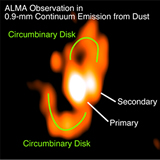 |
ALMA Observation of Gas Spirals as a Nursery of Binary Stars 0.9-mm dust-continuum image of the protostellar binary L1551 NE observed with ALMA (left), and that predicted from our supercomputer numerical simulation (right). Green curves in the left panel traces the ...(more) |
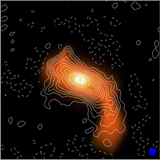 |
Infalling Flow toward a Keplerian Disk around the Protostar L1489 IRS (a) Schematic figure of our kinematic model. Red and blue arrows denote the directions of the outflow from the protostar. This protostar is surrounded by a Keplerian disk, and there ...(more) |
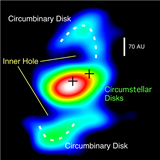 |
Dust distribution in the binary protostellar system L1551 NE observed with the SMA in 0.9 mm continuum. Dust distribution in the binary protostellar system L1551 NE observed with the SMA in 0.9 mm continuum. Crosses show the position of each binary component. Dashed curves delineate the ring-like ...(more) |
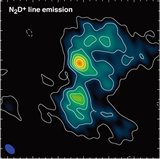 |
Two submm sources in the B1-b molecular cloud core. Two submm sources in the B1-b molecular cloud core. (Left) Thermal dust emission at 1.1 mm observed with the SMA (white contours) on top of the mid-IR image taken with ...(more) |
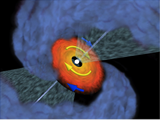 |
Youngest Protoplanetary Disk Discovered with ALMA ALMA observations by a team of astronomers led by Nadia Murillo and Shih-Ping Lai have found the youngest disk around a protostar to date, at an earlier stage than predicted ...(more) |
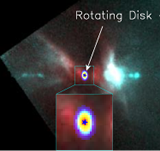 |
A rotating disk (from the SMA observations) is detected around a protostar launching a powerful jet in Orion A rotating disk (from the SMA observations) is detected around a protostar launching a powerful jet (from the HST observations of Reipurth et al 1999) in Orion. (Lee 2011, ApJ, ...(more) |
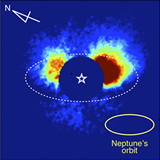 |
a layer of dust almost transparent in the near infrared sitting above the protoplanetary disk around RY Tau star (Left) An image in the near infrared (1.65 μm) around RY Tau, observed using the HiCIAO coronagraph of Subaru Telescope. This type of observation is preferred for faint emissions associated ...(more) |
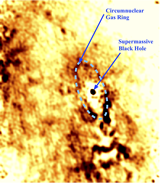 |
Dust distribution around the Galactic center Dust distribution around the Galactic center, as observed in 0.86 mm continuum with the SMA. ...(more) |
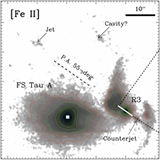 |
Is FS Tau B Driving an Asymmetric Jet? Left: near infrared [Fe II] 1.644 µm + continuum image of the wide binary FS Tau A and B. FS Tau B is not visible but its adjacent reflection nebula ...(more) |
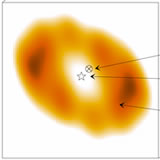 |
First detection of HC3N in protoplanetary disks The cyanoacetylene (HC3N) is a precursor of the organic molecules. It was observed for the first time in three protoplanetary disks thanks to IRAM 30m and PdBI observations. HC3N is ...(more) |
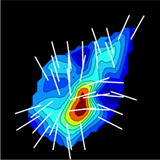 |
A New Method for Magnetic Field Strength Maps for Molecular Clouds Left Figure: SMA dust continuum observation at 345 GHz of the star-forming core W51 e2 with a resolution of about 0.7 arcsec. The color-wedge indicates the dust emission intensity. The ...(more) |
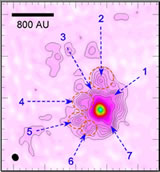 |
Spatially Resolving Substructures within the Massive Protostellar Envelope in Orion Left: 850 micron continuum image obtained with SMA. Right: Visibility-amplitude plot overlaid with modeled prestellar and protostellar cores. ...(more) |
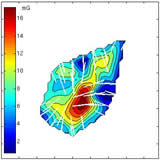 |
Mapping the Magnetic Field Strength in Molecular Clouds: W51 e2 Magnetic field strength map for the collapsing core W51 e2, calculated with the polarization-intensity gradient method (Koch, Tang and Ho, 2012, ApJ 747(1), 79, 2012-03). ...(more) |
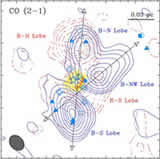 |
The Extremely High-Velocity Outflow from the Luminous Young Stellar Object G5.89-0.39 Left: Extremely high-velocity molecular outflows of G5.89-0.39 in CO (2-1) imaged with the SMA. Right: The outflowing gas temperature versus the gas velocity deduced from the LVG calculations. An increasing ...(more) |
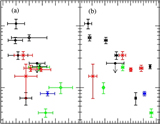 |
Deuterium Fractionation as an Evolutionary Probe in Massive Protostellar/Cluster Cores Deuterium fractionation, D_frac, vs. gas temperature (panel a), fitted line width (panel b), and CO depletion factor (panel c) in a number samples of massive star forming regions. ...(more) |
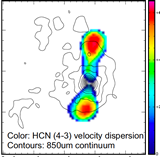 |
The Discovery of the Youngest Molecular Outflow Associated with an Intermediate-mass Protostellar Core in Orion MMS 6-main, an extremely young intermediate-mass protostellar core, located in the Orion Molecular Cloud 3 region (OMC-3) ...(more) |
 |
A Detailed Study of Spitzer-IRAC Emission in Herbig-Haro Objects. II. Interaction between Ejecta and Ambient Gas top: Distribution of molecular hydrogen emission in the L 1157 jet. Blue, green, and red colors show emissions at 3.6, 4.5, and 8.0μm observed with the Spitzer Space Telescope. The ...(more) |
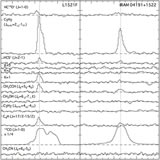 |
Carbon-chain and Organic Molecules around Very Low Luminosity Protostellar Objects of L1521F-IRS and IRAM 04191+1522 Molecular-line spectra toward L1521F (left) and IRAM 04191+1522 (right). Spectra from molecules such as C3H2, CH3CCH, and C4H, so-called "carbon-chain" molecules, are more intense in L1521F than in IRAM 04191+1522. ...(more) |
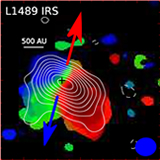 |
Rotating Gas Motion around Protostars Morphology (contour) and kinematics (color scale) of envelopes around a sample of Class 0 and I protostars seen in the C18O (2-1) emission observed with the SMA. The color scale ...(more) |
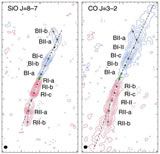 |
Extreme Active Molecular Jets in L1448C Distributions of the high velocity SiO (left panel) and CO (right) emission. The velocity ranges are ±51–70km s with respect to the systemic velocity. Green cross in each panel denotes ...(more) |
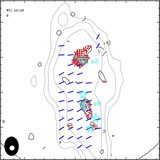 |
Morphology of magnetic field in high mass star formation region - W51 e2 and e8 cores Magnetic (B)-field maps of massive starformation region W51 e2/e8 from the SMA (red segments) at 870 μm and BIMA (blue segments) at 1.3 mm. ...(more) |
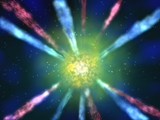 |
Explosive disintegration of a massive young stellar system in Orion Artist's conception of molecular outflow from a massive young stellar system in Orion ...(more) |
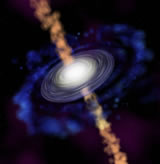 |
A still-forming protostar which is accreting material from a surrounding disk This artist's concept shows a still-forming protostar which is accreting material from a surrounding disk. Some of the material from the disk, rather than falling onto the star, is ejected ...(more) |
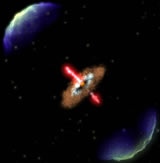 |
Brown dwarf ISO-Oph 102 An Artist's conception of the brown dwarf ISO-Oph 102 ...(more) |
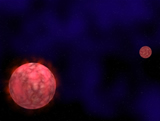 |
ASIAAa and ASIAAb A wide low-mass binary was discovered in the Galactic plane (Phan-Bao et al, 2008, MNRAS, 383, 831). The primary is an M0 star and the secondary is an L0 dwarf, ...(more) |
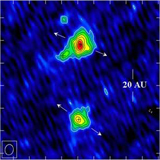 |
The 7 mm Continuum Image of the Binary Protostellar System L1551 IRS 5 The 7 mm continuum image of the binary protostellar system L1551 IRS 5 obtained with the VLA (Lim and Takakuwa 2006, ApJ, 653, 425). ...(more) |
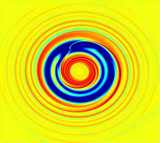 |
Numerical simulation of a planet interacting with a protoplanetary disk Numerical simulation of a planet interacting with a protoplanetary disk (Zhang, Yuan and Yen, in preparation). ...(more) |
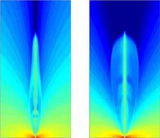 |
Snapshots of density structures Snapshots of density structures at 100 (top) and 1000 (bottom) years, respectively, for different anisotropy in the ambient mass distribution induced by magnetic field (Shang et al. 2006, ApJ, 649, ...(more) |
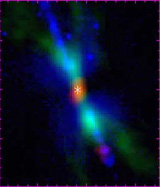 |
The HH212 molecular jet The HH212 molecular jet imaged with the SMA superposed on the H2 image (blue) adopted from McCaughrean et al. (2002). Left: C18O in red and 13CO in green. Right: SO ...(more) |
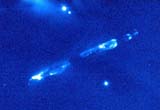 |
The HH211 outflow The HH211 outflow. Left: The H2 emission observed with the Very Large Telescope. Right: The approaching and receding SiO emission (blue and red contours, respectively) observed with the SMA superposed ...(more) |
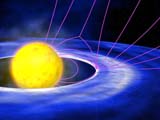 |
A schematic drawing of the X-wind model A schematic drawing of the X-wind model. ...(more) |
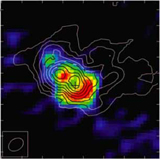 |
Protoplanetary disk around AB Aurigae Protoplanetary disk around AB Aurigae. Left: A comparison between the 0.85 mm dust continuum emission (color) and the CO(3-2) emission (contours) from the disk. Right: The CO(3-2) emission shown in ...(more) |
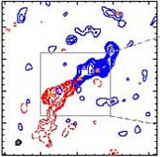 |
CO(3-2) molecular outflow from the high-mass young star IRAS 20126+4104 Top left: SMA image of the CO(3-2) molecular outflow from the high-mass young star IRAS 20126+4104. Top right: The velocity-channel map of the H2CO emission that arises from the dense ...(more) |